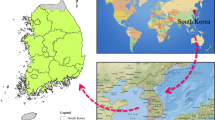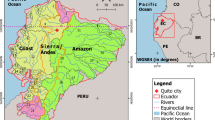Abstract
Soil erodibility (K), which has important influences on the accuracy of soil loss prediction, is a critical factor in the universal soil loss equation (USLE) and the models modified from it. As an effective tool to estimate soil loss, USLE has been widely applied in the US and around the world. Since the 1980s, the USLE framework for soil erosion prediction and assessment has been adopted in China. During its application in China, it has been noticed that the K values appear to be considerably lower than those in the US. This fact means that the estimated values of soil erodibility from existing methods, such as the nomograph-based database in the US, might be unreliable for their application in China and other areas. In this study, the K values for the main agricultural soils in China with those in the US were systematically compared based on the database from field runoff plots. Possible reasons for the differences were analyzed, and the reliability of soil erodibility estimation in areas outside the US was assessed. Results show that the average K factor for soils in the US is two to three times greater than that in China. For two typical stations with similar soil types located in the US and China, soil loss per rainfall erosivity is higher in the US than in China, although erosivity for the given rainfall in the US is sometimes smaller than that in China. There might be a great bias in soil loss prediction in China if the K value formulas derived from the database of the United States are used directly. This implies that the erodibility estimation formula currently used in the USLE model may need to be verified and revised.







Similar content being viewed by others
References
Adhikary PP, Tiwari SP, Mandal D, Lakaria BL, Madhu M (2014) Geospatial comparison of four models to predict soil erodibility in a semi-arid region of Central India. Environ Earth Sci 72:5049–5062
Auerswald K, Fiener P, Martin W, Elhaus D (2014) Use and misuse of the K factor equation in soil erosion modeling: an alternative equation for determining USLE nomograph soil erodibility values. Catena 118:220–225
Baskan O, Cebel H, Akgul S, Erpul G (2010) Conditional simulation of USLE/RUSLE soil erodibility factor by geostatistics in a Mediterranean Catchment, Turkey. Environ Earth Sci 60:1179–1187
Bonilla CA, Johnson OI (2012) Soil erodibility mapping and its correlation with soil properties in Central Chile. Geoderma 189–190:116–123
Borselli L, Torri D, Poesen J, Iaquinta P (2012) A robust algorithm for estimating soil erodibility in different climates. Catena 97:85–94
Buttafuoco G, Conforti M, Aucelli PPC, Robustelli G, Scarciglia F (2012) Assessing spatial uncertainty in mapping soil erodibility factor using geostatistical stochastic simulation. Environ Earth Sci 66:1111–1125
Chen X, Zhou J (2013) Volume-based soil particle fractal relation with soil erodibility in a small watershed of purple soil. Environ Earth Sci 70:1735–1746
Clark LA, McWilliams KM (1978) Soil survey of Page County, Iowa. Soil Conservation Service, US Department of Agriculture, Washington, DC
Ferreira V, Panagopoulos T, Andrade R, Guerrero C, Loures L (2015) Spatial variability of soil properties and soil erodibility in the Alqueva reservoir watershed. Solid Earth 6:383–392
Fu B, Chen L, Qiu Y, Wang J, Meng Q (2002) Land use structure and ecological process in the Hilly-gully region of Loess Plateau (in Chinese). The Commerical Press, Beijing
Gong L, Jin C, Sun W, Yang H, Wang J (2013) Loess plateau rainfalls characteristics and influences on soil erosion. J Food Agric Environ 11:2502–2505
Hammad AA, Lundekvam H, Børresen T (2005) Adaptation of RUSLE in the Eastern Part of the Mediterranean Region. Environ Manage 34:829–841
Hussein MH, Kariem TH, Othman AK (2007) Predicting soil erodibility in northern Iraq using natural runoff plot data. Soil Tillage Res 94:220–228
Jamshidi R, Dragovich D, Webb AA (2014) Catchment scale geostatistical simulation and uncertainty of soil erodibility using sequential Gaussian simulation. Environ Earth Sci 71:4965–4976
Kinnell PIA (2015) Accounting for the influence of runoff on event soil erodibilities associated with the EI 30 index in RUSLE2. Hydrol Process 29:1397–1405
Liu B, Nearing MA, Risse LM (1994) Slope gradient effects on soil loss for steep slopes. Trans ASAE 37:1835–1840
Lu H, Gallant J, Prosser IP, Moran C, Priestley G (2001) Prediction of sheet and rill erosion over the Australian Continent, Incorporating monthly soil loss distribution. Technical report 13/01. CSIRO land and water, Canberra, Australia
Martínez-Mena M, Williams AG, Ternan JL, Fitzjohn C (1998) Role of antecedent soil water content on aggregates stability in a semi-arid environment. Soil Tillage Res 48:71–80
Mulengera MK, Payton RW (1999) Estimating the USLE-soil erodibility factor in developing tropical countries. Trop Agric 76:17–22
O’Neal AM, Devereux RE (1924) Soil survey of Page County, Iowa. Bureau of soils, US Department of Agriculture, Government Printing Office, Washington, DC
Pimentel D, Harvey C, Resosudarmo P, Sinclair K, Kurz D, McNair M, Crist S, Shpritz L, Fitton L, Saffouri R, Blair R (1995) Environmental and economic costs of soil erosion and conservation benefits. Science 267:1117–1123
Quinton JN, Govers G, Oost KV, Bardgett RD (2010) The impact of agricultural soil erosion on biogeochemical cycling. Nat Geosci 3:311–314
Rejman J, Turski R, Paluszek J (1998) Spatial and temporal variations in erodibility of loess soil. Soil Tillage Res 46:61–68
Renard KG, Foster GR, Weesies GA, McCool DK, Yoder DC (1997) Predicting soil erosion by water: a guide to conservation planning with the revised universal soil loss equation (RUSLE), agricultural handbook no 703. US Department of Agriculture, Washington, DC
Römkens MJM, Roth CB, Nelson DW (1977) Erodibility of selected clay subsoils in relation to physical and chemical properties. Soil Sci Soc Am J 41:954–960
Römkens MJM, Helming K, Rasad SN (2001) Soil erosion under different rainfall intensities, surface roughness, and soil water regimes. Catena 46:103–123
Rosewell CJ (1990) The erodibility of five soils in New South Wales. In: Hamilton GJ, Howes KM, Attwater R (eds) Proceedings of the 5th Australian soil conservation conference, vol 3. Department Agriculture, Perth, Australia, pp 112–115
Rudolph A, Helming K, Diestel H (1997) Effect of antecedent soil water content and rainfall regime on microrelief changes. Soil Technol 10:69–81
Sanchis MPS, Torri D, Borselli L, Poesen J (2008) Climate effects on soil erodibility. Earth Surf Proc Land 33:1082–1097
Saygın SD, Basaran M, Ozcan AU, Dolarslan M, Timur OB, Yilman FE, Erpul G (2011) Land degradation assessment by geo-spatially modeling different soil erodibility equations in a semi-arid catchment. Environ Monit Assess 180:201–215
Shirazi MA, Boersma L (1984) A unifying quantitative analysis of soil texture. Soil Sci Soc Am J 48:142–147
Torri D, Poesen J, Borselli L (1997) Predictability and uncertainty of the soil erodibility factor using a global dataset. Catena 31:1–22
Vaezi AR, Sadeghi SHR (2011) Evaluating the RUSLE model and developing an empirical equation for estimating soil erodibility factor in a semi-arid region. Spanish J Agric Res 9:912–923
Vaezi AR, Sadeghi SHR, Bahrami HA, Mahdian MH (2008) Modeling the USLE K-factor for calcareous soils in northwestern Iran. Geomorphology 97:414–423
Veihe A (2002) The spatial variability of erodibility and its relation to soil types: a study from northern Ghana. Geoderma 106:101–120
Wang G, Gertner G, Liu X, Anderson A (2001) Uncertainty assessment of soil erodibility factor for revised universal soil loss equation. Catena 46:1–14
Williams JR, Jones CA, Dyke PT (1984) A modeling approach to determining the relationship between erosion and soil productivity. Trans ASAE 27:129–144
Wischmeier WH, Smith DD (1965) Predicting rainfall-erosion losses from cropland east of the Rocky Mountains—guide for selection of practices for soil and water conservation. Agriculture handbook no 282. US Department of Agriculture, Washington, DC
Wischmeier WH, Smith DD (1978) Predicting Rainfall erosion losses: a guide to conservation planning. Agriculture handbook no 537. US Department of Agriculture, Washington, DC
Wischmeier WH, Johnson CB, Cross BV (1971) Soil erodibility nomograph for farmland and construction sites. J Soil Water Conserv 26:189–193
Young RA, Mutchler CK (1977) Erodibility of some Minnesota soils. J Soil Water Conserv 32:180–182
Zhang K, Li S, Peng W, Yu B (2004) Erodibility of agricultural soils on the Loess Plateau of China. Soil Tillage Res 76:157–165
Zhang K, Shu A, Xu X, Yang Q, Yu B (2008) Soil erodibility and its estimation for agricultural soils in China. J Arid Environ 72:1002–1011
Acknowledgments
This research was supported by the National Natural Science Foundation of China (Grant nos. 41471224 and 41301282).
Author information
Authors and Affiliations
Corresponding author
Rights and permissions
About this article
Cite this article
Zhang, K., Lian, L. & Zhang, Z. Reliability of soil erodibility estimation in areas outside the US: a comparison of erodibility for main agricultural soils in the US and China. Environ Earth Sci 75, 252 (2016). https://doi.org/10.1007/s12665-015-4980-8
Received:
Accepted:
Published:
DOI: https://doi.org/10.1007/s12665-015-4980-8




